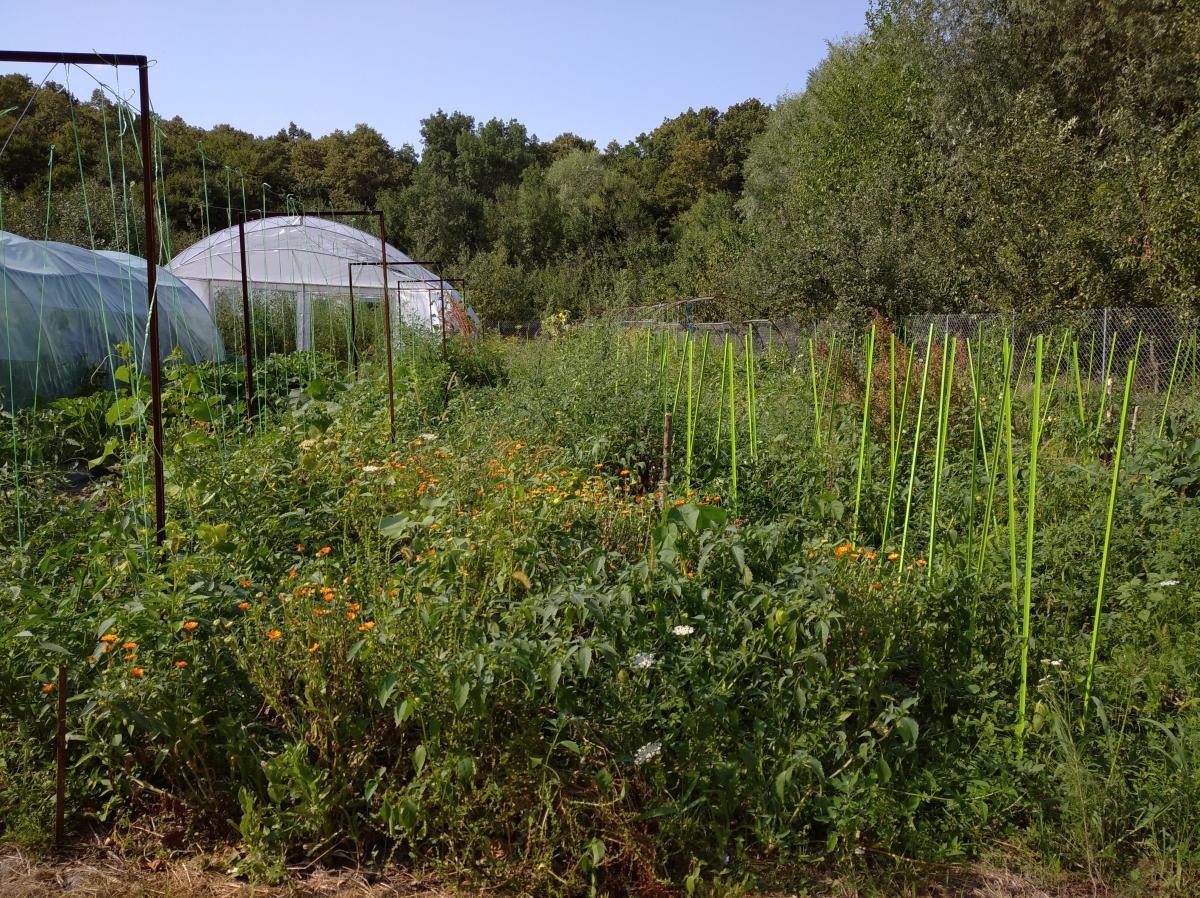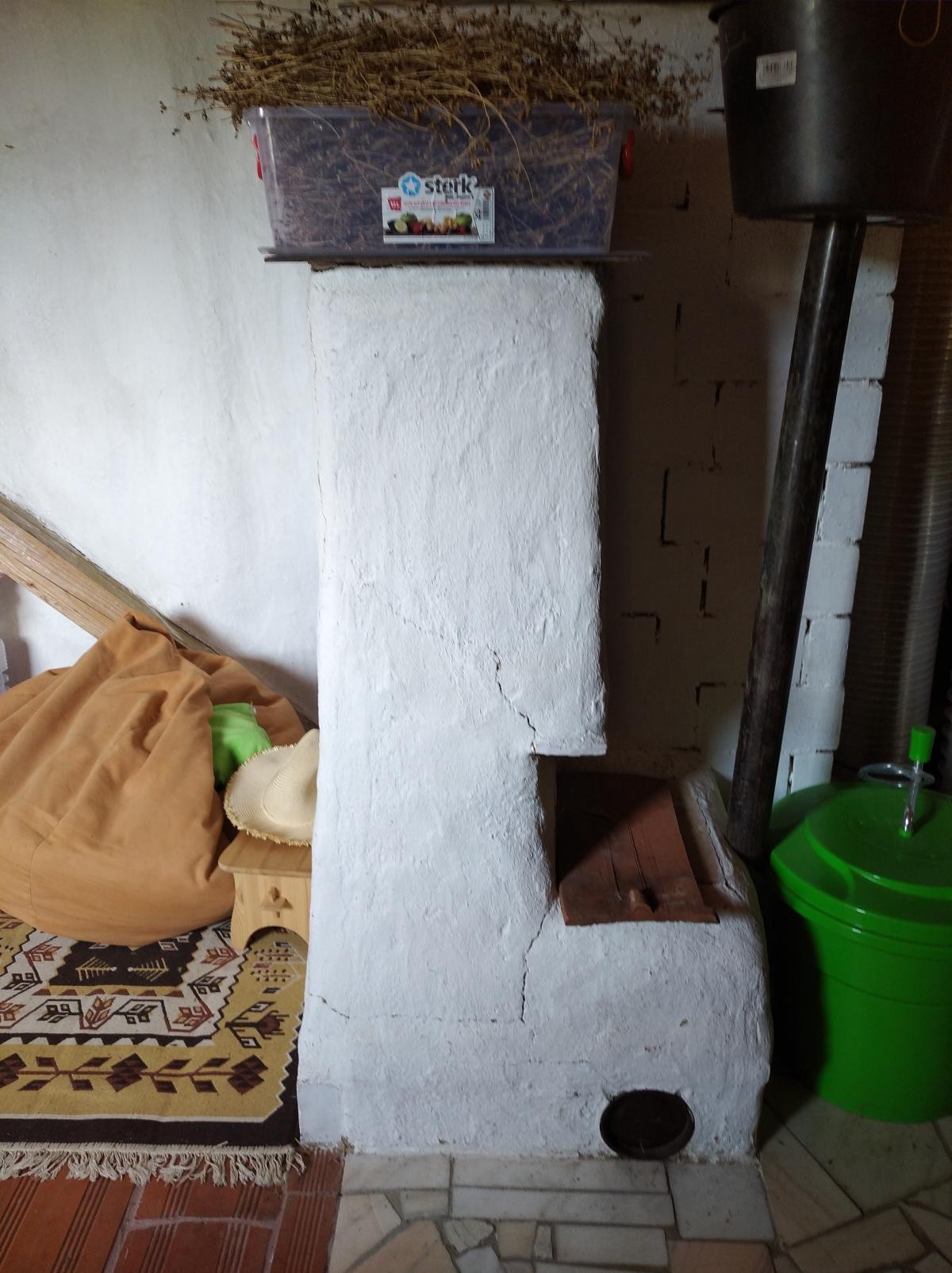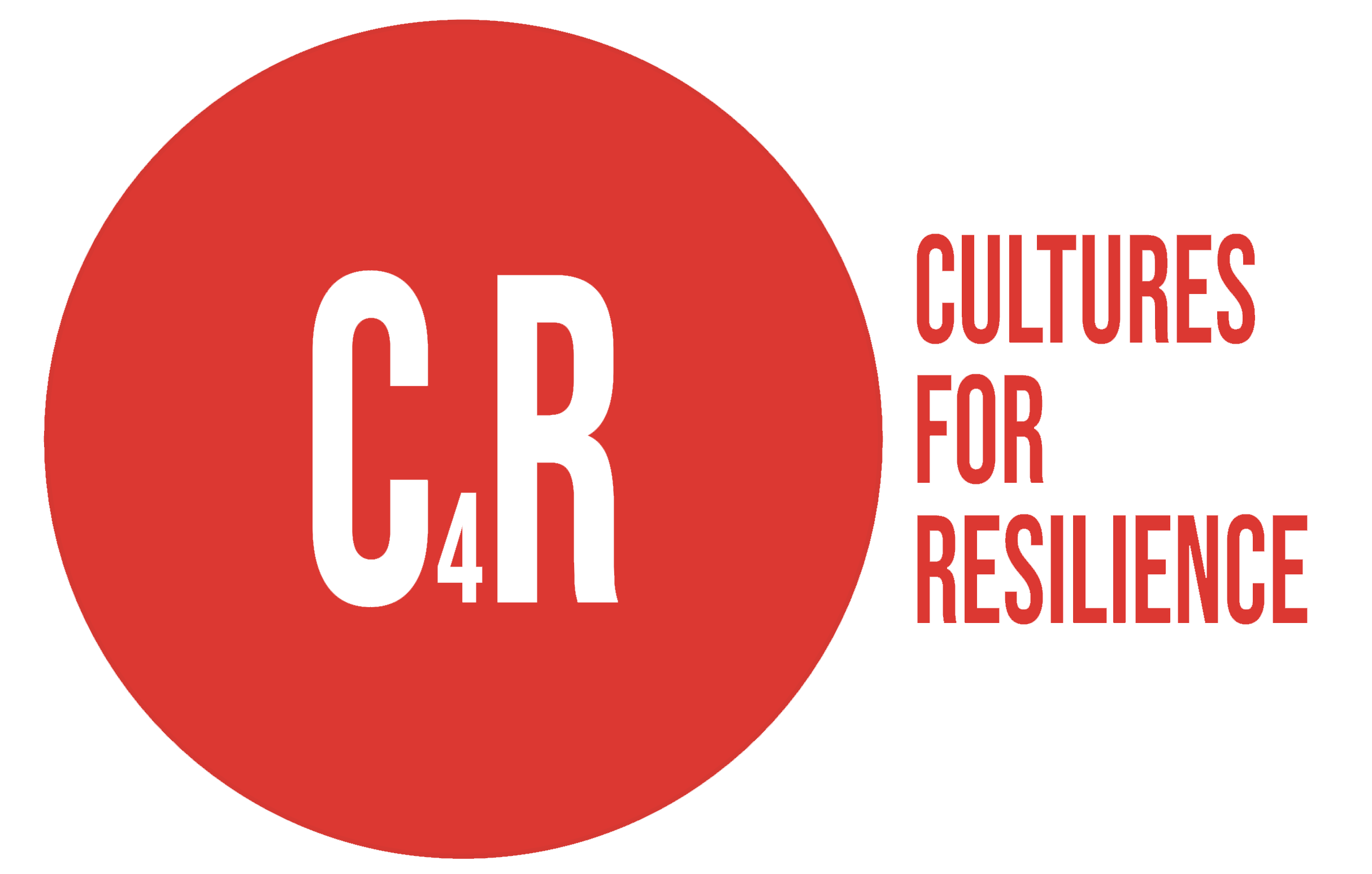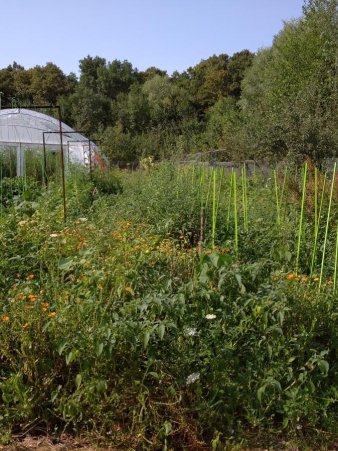Nettle Garden, a connection between consumers, producers, nourishment and land

Brândușa and Anselm moved to the countryside in 2013, to the village of Stanciova, Timiș county, drawn towards the idea of a lifestyle more deeply connected to the land and the nourishment it produces. At the same time, the two saw moving to the countryside also as a break from the academic medium, whose essentially theoretical products they didn’t consider too useful. The two met in Germany during their studies, Anselm being a Belgian citizen. Brândușa graduated with a Master’s degree in Rural Development and, prior to moving to Stanciova, she spent a study internship in India. The choice to settle their household in Stanciova was grounded on the existence of a community of young people relocated from Timișoara at the beginning of the 2000s; the group decided to move to the countryside with the purpose of creating a community and of implementing rural development programs. Drawn by the promotion the community made online, through a blog, Brândușa and Anselm came into contact with the members and moved to the village, with the possibility of living in a house renovated by the members of the community; “we only brought our backpacks with us”, Brândușa highlights. Shortly after coming to the village, Brândușa and Anselm bought a piece of land they could afford, with the purpose of building a house to live in and planting a garden. The construction of the house took two years, from 2014 to 2016, during which time the two lived in the community house. For the construction they analysed various alternative construction techniques. They mainly had to choose between a house made from cob and one made from bales, in the end opting for a house made from wheat bales built on a wooden structure, which they considered it offered better thermal isolation.
Nettle Garden came into being from the desire of Brândușa and Anselm to produce ecological nourishment for themselves, but for other people, too, which they would sell in a community-supported agriculture (CSA) system. Brândușa manifested interest towards this form of agriculture during her Master’s degree, when she wrote her dissertation about this type of food production and distribution and which she wanted to try first-hand: “and this is why the dream slowly developed, we settle close to Timișoara, all good, so we can start growing vegetables at some point”. Beginning with the spring of 2021, the two managed to gather enough surplus in their production to start selling vegetables, in a CSA system, to around 10-12 consumers in Timișoara who subscribed to their baskets. Nettle Garden is basically the name Brândușa and Anselm gave to their household. It is about 2000 sq.m. and comprises the little bale house, with an annex housing the compost dry toilet and the shower, the vegetable garden, a few fruit trees which were already planted when they bought the land, two solariums, enclosed spaces for geese. In the farmyard, there were tools and farm equipment: electric-hoe, pitchfork to loosen the soil, a “wire boat” whipped up by Anselm to carry hay, but also spaces for stable waste and for compost. Two dogs and a few cats had their homes in the garden. Aside from the garden, they use two adjacent lands to raise hens and geese. One of the lands is rented from a local, and they use another one, abandoned and with uncertain ownership, to raise geese, reclaiming the priority, at least a moral one, in favour of the one who uses the land. Recently, they leased two ha of farmland, but they haven’t undertaken any farm work there yet. The dwelling space has a relatively small area, being built on the footprint of an older mudbrick house. It is composed from a room that serves as a living room, a kitchen, a studio, and an attic accessed through an abrupt wooden stairway, which is used as a bedroom and storage space. The house is heated with a stove built by Anselm using the system of a “rocket-stove”, which he adapted: instead of thick logs, it uses sticks and wooden shards which burn intensely to maximize the efficiency of the burn; the addition he brought to the system is a space made from refractory brick meant to store and radiate heat. Around the house, Brândușa and Anselm were in the process of painting a cement terrace, which they built in order to avoid spreading mud around.

When I arrived at Nettle Garden, Anselm was experimenting with a new seeding method, using an instrument he DIY-ed from a leaf blower, to which he attached a plastic bottle used as a seed recipient. He explained that this instrument will help him in the no-till farming they are practicing, where the land is not ploughed or dug, but the superior humus layer is permanently enriched with the purpose of keeping life inside the soil as much as possible: “all the earthworms and the insects in the soil remain there and live their life”, says Anselm. The two insist upon the ideal of keeping life in the soil by using no-till farming, saying they do not agree with ploughing the land every year, as is the usual in classic agriculture, because, on the one hand, it destroys the living things in the soil, and on the other hand, it creates a hardpan layer, below the limit where the plough works, which becomes waterproof. Their technique is sowing the crop directly onto the soil, which they, eventually, lay to the ground or chop, to sow into this one the next crop which will be harvested, or the seedlings. Anselm explains it this way:
“I’ve seeded it and the triticale grew all winter. It just sits there, growing, covering the soil and it turns into straws, and when the time came to transplant, we chopped everything with the brush cutter and we were left with a layer of minced straws. (…) And then you haven’t ploughed the soil, you don’t lose water, during winter something grew, I mean, if it was a little bit warmer and the sun would shine, something would grow and would become organic matter, which means it wasn’t dead. The more it
grows and you have organic matter, the more you enrich the soil and it becomes looser, water seeps easier, there’s more life
and it’s more fertile”.While Anselm was experimenting with the blower, together with Brândușa we made seedlings, with the help of a small manual press, by making little cubes of soil where we planted turnip seeds. She also presented to me a device made by Anselm, which made 200 seedlings at once, which they didn’t use though, as they preferred to plant different varieties. In fact, the garden was abundant in vegetable varieties. I helped Brândușa with harvesting them for the second day distribution. The tomatoes were, by far, the most prevalent; the 200 tomato stalks were very diverse, totalling 10 different varieties. Similarly, the eggplants were purple and white and in various shapes, the courgettes were too, of different varieties. Furthermore, Brândușa confesses she is passionate about experimenting with various uncommon vegetables: tomatillos, cucamelon, Palestinian white cucumbers, as well as mizuna, arugula, mangold. She even admits that this year’s diversity can also be a disadvantage and that she would prefer in the future to settle on less varieties, with the intention to do research among the consumers to determine the varieties she should settle on. The vegetables are planted in alternation with flowers; for example, between tomato rows one finds rows of marigolds, Brândușa saying she would want even more, with the purpose of helping both the pollinators, as well as pest control. She says associating marigolds with tomatoes is a classic combination, as they remove the tomato pests. The ecological agriculture Brândușa and Anselm practice implies the plants are to be exposed as rarely as possible to pest control treatments. The products they use are, most often, nettle soaks made by Brândușa herself, and on the rare occasions where they were forced to buy mass market products, they only used products which are certified for ecological crops and waited a longer time than recommended until the harvest. Although they are not certified as bio producers, Brândușa and Anselm claim they fulfil all the organic farming conditions, the cost of obtaining the certificate being the sole reason they don’t have one yet. The two use exclusively compost and stable waste, the latter which they have to buy for prices they find steep, considering they don’t own animals and, according to them, less and less people in the village do. The compost that results from matter coming from the composting toilet (humanure) isn’t used, because they aren’t fully confident in its safety, being rather a way to ecologically eliminate physiological waste, but sometimes they use it when planting trees. What they do use in the garden from the composting toilet is the liquid part: “diluted pee, because it doesn’t have pathogens and so it’s a good source of nitrogen and phosphorus. We dilute it 1/10”. For the seedlings they either use the seeds they kept, or bought online from other gardeners, from Romania and the Republic of Moldova. It is very important for Brândușa to avoid hybrid seeds, both because they cannot be saved in order to reproduce a similar variety, and because, for ideological reasons, she doesn’t accept buying seeds which are conceived so that the plant cannot be reproduced, and this happens even in the case of plants whose seeds she usually doesn’t save, such as carrots. Aside from the vegetable garden, Brândușa and Anselm are raising hens and geese; they bred the geese from a few goslings they bought and they sacrifice the birds themselves. From the woods, the two gather wild garlic, nettles and mushrooms, rosehip and cornelian cherry; the forest is also a source of dry wood for the fire and even logs which they used to make pillars for the terrace. Brândușa’s and Anselm’s lifestyle doesn’t exclude also using modern techniques and instruments in the garden. The vegetables are watered using a drip irrigation system, the birds are cooped up with an electric fence – the two agree it has been very effective in preventing fox attacks, which at some point they had to fight away. They also wish for a tractor, as a distant goal, to which they could attach no-till farming devices, because ”a tractor isn’t necessarily just a plough”, she explains.

And so, the production techniques and the domestic routines of the two are in accordance with an ecological lifestyle, which highlights the respect shown to the land and nourishment. Besides, the domestic routines can hardly be separated from the food production, given that the two aim to live, as much as possible, with and from the land. As part of this lifestyle, the two adapt the classical practices, techniques and means of production, and experiment with alternative practices, routines and tools, which differ from those of the locals. The differences in practice have been noticed by the locals, which were curious and asked for information about how to build a house of bales, while suggesting other techniques: “kind of like, you won’t make it, you know. Or when we were building, neighbours would pass by and tell us, wouldn’t it be cheaper?, something something, if you’d use cinder blocks… I’m not using cinder blocks, that’s that”, Brândușa points out. But she describes the relationship with the villagers as a good one, being bothered however by the neighbours which are used to burning trash as a way of cleaning, or the ones which throw away trash next to their fence, despite the fact that there’s a sanitation and waste sorting service in the village. Brândușa also earned a reputation by being an educator in the village. At the same time, she helps the neighbours with repairing bicycles; she had a repair shop in Timișoara and also organized a repair camp in the village, “where people from other workshops in Europe came over, this kind of anarchist, independent shops”. But she gave up her repair shop so she would dedicate herself to the garden. However, at the present moment, Brândușa and Anselm cannot completely sustain themselves from farming. Anselm is a part-time (60%) employee as an inspector for ecological agriculture, while Brândușa gave up her jobs, including a part-time she had with EcoRuralis, to work in food production.
The products of the Nettle Garden are distributed weekly, on a Wednesday, in the Faber space in Timișoara. The two haul the vegetables with their own car and they arrange them in the space where people come to pick it up. The distribution is made using a community-supported agriculture system, in collaboration with the Association for Sustaining Peasant Agriculture, towards around 10 to 12 subscribers. Brândușa shows that this system is not market-oriented, given that the consumers are willing to pay a higher price to sustain ecological peasant initiatives, maybe without expecting an equivalent return: “from what I heard, for some of them it’s important that we have a connection, they’re people who can afford to invest a certain sum of money into a household close to Timișoara, maybe even without getting so much in return, but with the thought of helping some people”. At the same time, her main objective is “being able to feed more people”. The vegetables are picked by Brândușa and Anselm on the distribution days, so that they are as fresh as possible. Alongside vegetables, their baskets include, as a bonus, eggs or plants picked form the forest: nettles, wild garlic. The harvest is weighed prior to the distribution and Brândușa counts the vegetables for each consumer, without portioning the quantities. The subscribers are encouraged to bring paper bags to get their products, after each portion is weighed with a scale. A WhatsApp group is used to organize the distribution and keep in touch. Distribution doesn’t mean just delivering the vegetables, but also, as Brândușa points out, knowledge about how they should be cooked, especially the lesser known ones, like tomatillos: “I’ll feel sorry if they don’t use something because they don’t know how and it ends up in the compost. I’d feel so bad, because I worried about that fruit. So it’s in my interest if they eat each gram of the vegetables they receive. (…) we talk on the spot, we look for recipes, they give advice to each other, we have a WhatsApp group and we post recipes there”. The distribution takes place in a generally sociable atmosphere, the relatively small group that comes constantly for the delivery showing a certain cohesion; they often stay for a chat and to socialize after the vegetables are handed out. The distribution space, specifically chosen by Anselm in a popular enough place for youngsters in Timișoara, is featuring various pieces of urban furniture made from wood, coloured in black and purple, in a geometric, modern style. Inside the space, you find a restaurant with a terrace and various shops placed in metal containers, selling even craft beer. Thus, after the distribution of the vegetables, for an hour or two, the consumers socialize and drink beer and other stuff they buy on the spot. The subscriber group comprises middle class people; a Political Science professor from the Western University in Timișoara, also a subscriber, notices: “this thing is very posh, professors, artists. I would like something for the working class”.
At the end of the night, together with Brândușa and Anselm, we collected the crates and went back to Stanciova. A few members of the consumers group left together to keep hanging out in some other place in the Fabric neighbourhood.
Research and text by Alexandru Vârtej
Translation by Dana Andrei
The research is part of Regenerative-Reliable-Resourceful, the mapping of resilient practices in the Romanian countryside that tranzit.ro develops in the frame of C4R and of the Experimental Station for Research.

